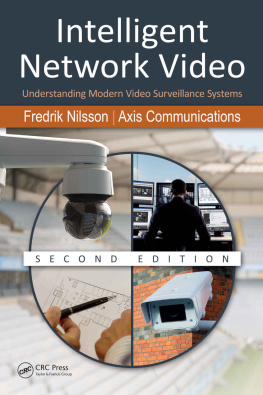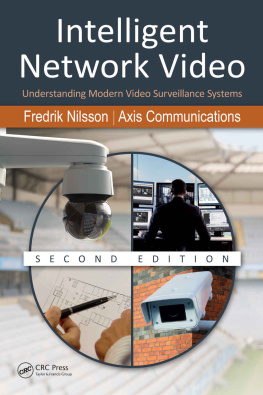Dufour - Intelligent Video Surveillance Systems
Here you can read online Dufour - Intelligent Video Surveillance Systems full text of the book (entire story) in english for free. Download pdf and epub, get meaning, cover and reviews about this ebook. City: London, year: 2012, publisher: ISTE Ltd and John Wiley & Sons Inc, genre: Romance novel. Description of the work, (preface) as well as reviews are available. Best literature library LitArk.com created for fans of good reading and offers a wide selection of genres:
Romance novel
Science fiction
Adventure
Detective
Science
History
Home and family
Prose
Art
Politics
Computer
Non-fiction
Religion
Business
Children
Humor
Choose a favorite category and find really read worthwhile books. Enjoy immersion in the world of imagination, feel the emotions of the characters or learn something new for yourself, make an fascinating discovery.
- Book:Intelligent Video Surveillance Systems
- Author:
- Publisher:ISTE Ltd and John Wiley & Sons Inc
- Genre:
- Year:2012
- City:London
- Rating:5 / 5
- Favourites:Add to favourites
- Your mark:
- 100
- 1
- 2
- 3
- 4
- 5
Intelligent Video Surveillance Systems: summary, description and annotation
We offer to read an annotation, description, summary or preface (depends on what the author of the book "Intelligent Video Surveillance Systems" wrote himself). If you haven't found the necessary information about the book — write in the comments, we will try to find it.
Dufour: author's other books
Who wrote Intelligent Video Surveillance Systems? Find out the surname, the name of the author of the book and a list of all author's works by series.
Intelligent Video Surveillance Systems — read online for free the complete book (whole text) full work
Below is the text of the book, divided by pages. System saving the place of the last page read, allows you to conveniently read the book "Intelligent Video Surveillance Systems" online for free, without having to search again every time where you left off. Put a bookmark, and you can go to the page where you finished reading at any time.
Font size:
Interval:
Bookmark:


First published 2013 in Great Britain and the United States by ISTE Ltd and John Wiley & Sons, Inc.
Apart from any fair dealing for the purposes of research or private study, or criticism or review, as permitted under the Copyright, Designs and Patents Act 1988, this publication may only be reproduced, stored or transmitted, in any form or by any means, with the prior permission in writing of the publishers, or in the case of reprographic reproduction in accordance with the terms and licenses issued by the CLA. Enquiries concerning reproduction outside these terms should be sent to the publishers at the undermentioned address:
ISTE Ltd
27-37 St Georges Road
London SW19 4EU
UK
www.iste.co.uk
John Wiley & Sons, Inc.
111 River Street
Hoboken, NJ 07030
USA
www.wiley.com
ISTE Ltd 2013
The rights of Jean-Yves Dufour to be identified as the author of this work have been asserted by him in accordance with the Copyright, Designs and Patents Act 1988.
Library of Congress Control Number: 2012946584
British Library Cataloguing-in-Publication Data
A CIP record for this book is available from the British Library
ISBN: 978-1-84821-433-0

Video surveillance consists of remotely watching public or private spaces using cameras. The images captured by these cameras are usually transmitted to a control center and immediately viewed by operators (real-time exploitation) and/or recorded and then analyzed on request (a posteriori exploitation) following a particular event (an accident, an assault, a robbery, an attack, etc.), for the purposes of investigation and/or evidence gathering.
Convenience stores, railways and air transport sectors are, in fact, the largest users of video surveillance. These three sectors alone account for over 60% of the cameras installed worldwide. Today, even the smallest sales points have four cameras per 80 m2 of the shop floor. Surveillance of traffic areas to help ensure the smooth flow of the traffic and the capacity for swift intervention in case of an accident brings the figure upto 80%, in terms of the number of installations. The protection of other critical infrastructures accounts for a further 10% of installations. The proliferation of cameras in pedestrian urban areas is a more recent phenomenon, and is responsible for the rest of the distribution.
Over the past 30+ years, we have seen a constant increase in the number of cameras in urban areas. In many people's minds, the reason behind this trend is a concern for personal protection, sparked first by a rise in crime (a steady increase in assaults in public areas) and then by the increase in terrorism over the past 10 years. However, this aspect cannot mask the multiplication of cameras in train stations, airports and shopping centers.
The defense of people and assets, which states are so eager to guarantee, has benefited greatly from two major technological breakthroughs: first, the advent of very high capacity digital video recorders (DVRs) and, second, the development of Internet protocol (IP) networks and so-called IP cameras. The latter breakthrough enables the images delivered by cameras to be distributed to various processing centers. This facilitates the (re)configuration of the system and the transmission of all the data (images, metadata, commands, etc.) over the same channel.
Today, we are reaping the benefits of these technological advances for the protection of critical infrastructures. Indeed, it is becoming easier to ensure interoperability with other protection or security systems (access monitoring, barriers, fire alarms, etc.). This facility is often accompanied by a poorer quality of images than those delivered by CCTV cameras.
Currently, the evolution of the urban security market is leading to the worldwide deployment of very extensive systems, consisting of hundreds or even thousands of cameras. While such systems, operated in clusters, have long been the panacea for transport operators, they have become unavoidable in urban areas.
All these systems generate enormous quantities of video data, which render real-time exploitation solely by humans near-impossible, and extremely long and very costly in terms of human resources. These systems have now come to be used essentially as operational aids. They are a tool for planning and support in the intervention of a protective force, be it in an urban area or in major transport centers.
Video analytics is intended to solve the problem of the incapability to exploit video streams in real time for the purposes of detection or anticipation. It involves having the videos analyzed by algorithms that detect and track objects of interest (usually people or vehicles) over time, and that indicate the presence of events or suspect behavior involving these objects. The aim is to be able to alert operators in suspicious situations in real time, economize on the bandwidth by only transmitting data that are pertinent for surveillance and improve searching capabilities in the archived sequences, by adding data relating to the content (metadata) to the videos.
The Holy Grail of video analytics can be summed up as the three main automatic functions: real-time detection of expected or unexpected events, capability to replay the events leading up to the observed situation in real time and the capacity to analyze the video a posteriori and retrace the root of an event.
Belonging to the wider academic domain of computer vision, video analytics has aroused a phenomenal surge of interest since the early 2000s, resulting in concrete terms in the proliferation of companies developing video analytics software worldwide and the setting up of a large number of collaborative projects(e.g. SERKET, CROMATICA, PRISMATICA, ADVISOR, CARETAKER, VIEWS, BOSS, LINDO, VANAHEIM and VICOMO, all funded by the European union).
Video analytics is also the topic of various academic gatherings. For instance, on a near-yearly basis since 1998, the Institute of Electrical and Electronics Engineers (IEEE) has organized an international conference: Advanced Video and Signal- based Surveillance (AVSS), which has become a reference point in the domain, and facilitates a regular meeting for people belonging to the fields of research, industry and governmental agencies.
Although motion detection, object detection and tracking or license plate recognition technologies have now been shown to be effective in controlled environments, very few systems are, as yet, sufficiently resistant to the changing environment and the complexity of urban scenes. Furthermore, the recognition of objects and individuals in complex scenes, along with the recognition of complex or "unusual" behavior, is one of the greatest challenges faced by researchers in this domain.
Furthermore, new applications, such as consumer behavior analysis and the search for target videos on the Internet, could accelerate the rise of video analytics.
The aims of this book are to highlight the operational attempts for video analytics, to identify possible driving forces behind potential evolutions in years to come and, above all, to present the state of the art and the technological hurdles that have yet to be overcome. This book is intended for an audience of students and young researchers in the field of computer visualization, and for engineers involved in large-scale video surveillance projects.
Next pageFont size:
Interval:
Bookmark:
Similar books «Intelligent Video Surveillance Systems»
Look at similar books to Intelligent Video Surveillance Systems. We have selected literature similar in name and meaning in the hope of providing readers with more options to find new, interesting, not yet read works.
Discussion, reviews of the book Intelligent Video Surveillance Systems and just readers' own opinions. Leave your comments, write what you think about the work, its meaning or the main characters. Specify what exactly you liked and what you didn't like, and why you think so.











